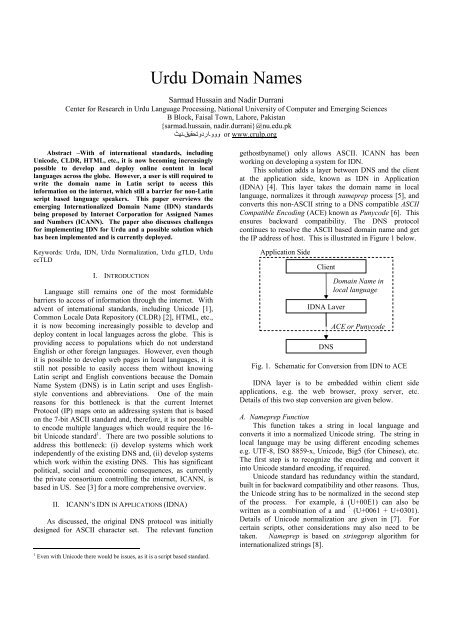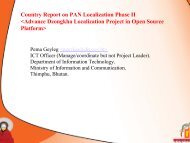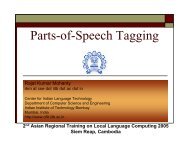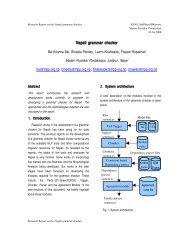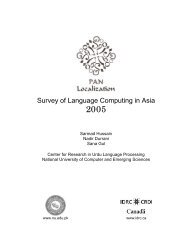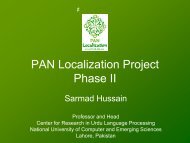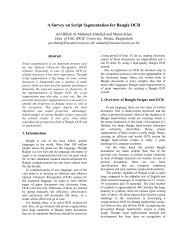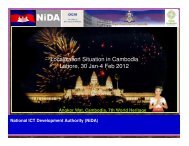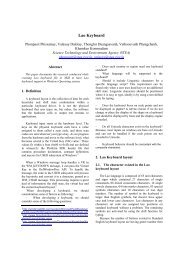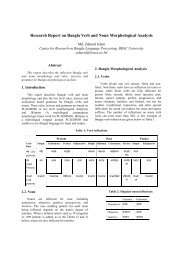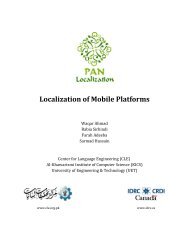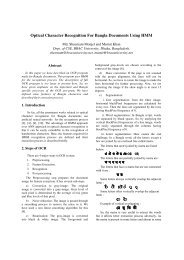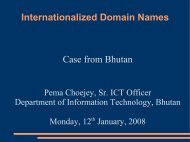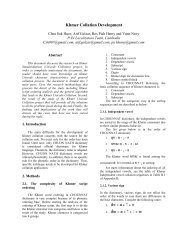Urdu Domain Names - PAN Localization
Urdu Domain Names - PAN Localization
Urdu Domain Names - PAN Localization
Create successful ePaper yourself
Turn your PDF publications into a flip-book with our unique Google optimized e-Paper software.
<strong>Urdu</strong> <strong>Domain</strong> <strong>Names</strong><br />
Sarmad Hussain and Nadir Durrani<br />
Center for Research in <strong>Urdu</strong> Language Processing, National University of Computer and Emerging Sciences<br />
B Block, Faisal Town, Lahore, Pakistan<br />
{sarmad.hussain, nadir.durrani}@nu.edu.pk<br />
or www.crulp.org ٹ<br />
ووو۔اردوتحقيق۔ني<br />
Abstract –With of international standards, including<br />
Unicode, CLDR, HTML, etc., it is now becoming increasingly<br />
possible to develop and deploy online content in local<br />
languages across the globe. However, a user is still required to<br />
write the domain name in Latin script to access this<br />
information on the internet, which still a barrier for non-Latin<br />
script based language speakers. This paper overviews the<br />
emerging Internationalized <strong>Domain</strong> ame (ID) standards<br />
being proposed by Internet Corporation for Assigned ames<br />
and umbers (ICA). The paper also discusses challenges<br />
for implementing ID for <strong>Urdu</strong> and a possible solution which<br />
has been implemented and is currently deployed.<br />
Keywords: <strong>Urdu</strong>, IDN, <strong>Urdu</strong> Normalization, <strong>Urdu</strong> gTLD, <strong>Urdu</strong><br />
ccTLD<br />
I. INTRODUCTION<br />
Language still remains one of the most formidable<br />
barriers to access of information through the internet. With<br />
advent of international standards, including Unicode [1],<br />
Common Locale Data Repository (CLDR) [2], HTML, etc.,<br />
it is now becoming increasingly possible to develop and<br />
deploy content in local languages across the globe. This is<br />
providing access to populations which do not understand<br />
English or other foreign languages. However, even though<br />
it is possible to develop web pages in local languages, it is<br />
still not possible to easily access them without knowing<br />
Latin script and English conventions because the <strong>Domain</strong><br />
Name System (DNS) is in Latin script and uses Englishstyle<br />
conventions and abbreviations. One of the main<br />
reasons for this bottleneck is that the current Internet<br />
Protocol (IP) maps onto an addressing system that is based<br />
on the 7-bit ASCII standard and, therefore, it is not possible<br />
to encode multiple languages which would require the 16-<br />
bit Unicode standard 1 . There are two possible solutions to<br />
address this bottleneck: (i) develop systems which work<br />
independently of the existing DNS and, (ii) develop systems<br />
which work within the existing DNS. This has significant<br />
political, social and economic consequences, as currently<br />
the private consortium controlling the internet, ICANN, is<br />
based in US. See [3] for a more comprehensive overview.<br />
II. ICANN’S IDN IN APPLICATIONS (IDNA)<br />
As discussed, the original DNS protocol was initially<br />
designed for ASCII character set. The relevant function<br />
1 Even with Unicode there would be issues, as it is a script based standard.<br />
gethostbyname() only allows ASCII. ICANN has been<br />
working on developing a system for IDN.<br />
This solution adds a layer between DNS and the client<br />
at the application side, known as IDN in Application<br />
(IDNA) [4]. This layer takes the domain name in local<br />
language, normalizes it through nameprep process [5], and<br />
converts this non-ASCII string to a DNS compatible ASCII<br />
Compatible Encoding (ACE) known as Punycode [6]. This<br />
ensures backward compatibility. The DNS protocol<br />
continues to resolve the ASCII based domain name and get<br />
the IP address of host. This is illustrated in Figure 1 below.<br />
Application Side<br />
Client<br />
IDNA Layer<br />
DNS<br />
<strong>Domain</strong> ame in<br />
local language<br />
ACE or Punycode<br />
Fig. 1. Schematic for Conversion from IDN to ACE<br />
IDNA layer is to be embedded within client side<br />
applications, e.g. the web browser, proxy server, etc.<br />
Details of this two step conversion are given below.<br />
A. ameprep Function<br />
This function takes a string in local language and<br />
converts it into a normalized Unicode string. The string in<br />
local language may be using different encoding schemes<br />
e.g. UTF-8, ISO 8859-x, Unicode, Big5 (for Chinese), etc.<br />
The first step is to recognize the encoding and convert it<br />
into Unicode standard encoding, if required.<br />
Unicode standard has redundancy within the standard,<br />
built in for backward compatibility and other reasons. Thus,<br />
the Unicode string has to be normalized in the second step<br />
of the process. For example, á (U+00E1) can also be<br />
written as a combination of a and ́ (U+0061 + U+0301).<br />
Details of Unicode normalization are given in [7]. For<br />
certain scripts, other considerations may also need to be<br />
taken. ameprep is based on stringprep algorithm for<br />
internationalized strings [8].
B. Punycode<br />
In order to make the hostname DNS compatible the<br />
Unicode string has to be converted to ACE. Many schemes<br />
have been proposed in this regard. Punycode is a bootstring<br />
encoding mechanism that uniquely converts Unicode<br />
string to the allowed ASCII based encoding. This<br />
conversion takes place through an algorithm known as<br />
ToASCII(). ToUnicode() converts back ASCII based<br />
encoding into Unicode compatible scheme. Punycode uses<br />
conventional ASCII i.e. a-z, 0-9 and hyphen, for backward<br />
compatibility [6].<br />
The ToASCII function is applied separately to all the<br />
labels in domain name. There is a possibility that the<br />
generated Punycode is already a registered domain. For<br />
example, when http://www.ا.com is converted using<br />
ToASCII() function, the domain name ا (U+0627) is<br />
converted to ASCII string “mgb” but http://www.mgb.com<br />
may already be a registered domain. To avoid significant<br />
duplication, all such conversions through the ToASCII()<br />
function are appended with a four character prefix “xn--”.<br />
The URL http://www.ا.com is therefore converted into<br />
http://www.xn--mgb.com.<br />
III. EVALUATION OF DNS AND IDNA<br />
Apart from political issues, there are also some<br />
additional criticism associated with DNS system generally<br />
and specifically for IDNA.<br />
Limitation of DNS to encode many languages due to its<br />
ASCII base has already been discussed.<br />
RFC 920 [9] expanded the addressing convention to<br />
include top level domains (TLDs) like .edu, .com, .org, etc.<br />
However, now these are being used beyond the intended<br />
usage. For example, .com.la was sold by Lao PDR to a<br />
group which is using this TLD for Los Angeles city, and<br />
Tuvalu’s county code .tv is being used by names associated<br />
with television.<br />
It is currently being debated whether IDN should ride<br />
over the existing DNS system, as discussed. ICANN argues<br />
for the importance of a single root. However, there are also<br />
other parallel namespaces which are successfully working,<br />
e.g. for companies like AOL and Skype, and for countries<br />
like China Internet Network Information Center (CNNIC),<br />
Japan Network Information Center (JPNIC) and Korea<br />
Network Information Center (KRNIC), which are<br />
maintaining thousands of addresses. And other domains<br />
like telephone exchanges have shown that parallel systems<br />
can co-exist and effectively communicate with proper<br />
collaboration [3].<br />
Though a unique Internet Protocol (IP) number<br />
identifies each address, DNS was introduced for the ease of<br />
users. However, DNS is not always visually unique, which<br />
can cause malicious or unintentional intervention. For<br />
example, lower case “L” in English looks similar to the<br />
upper case “I” or the digit “1” in some fonts. Thus, the<br />
website www.paypal.com may be written in different ways<br />
which are visually identical. Same is the case with the digit<br />
“0” and the upper case letter “O”. This confusion could be<br />
even more profound if additional scripts are incorporated in<br />
the URL to enable multilingual IDN and more phishing [10]<br />
attacks are possible [3].<br />
A variety of solutions have been considered to control<br />
the confusion that is caused by the visual similarity within a<br />
script, and enhanced by allowing multilingual domain<br />
names. At least one way to restrict some confusion is to<br />
disallow use of characters from different script blocks in<br />
Unicode to be used within a domain name. Thus, purely<br />
Arabic script domain names may be allowed but domain<br />
names with Arabic letters mixed with Latin characters may<br />
not be allowed. However, some languages do traditionally<br />
use some letters across scripts (as encoded in Unicode) and<br />
therefore some mechanism still needs to allow non-arbitrary<br />
and pre-defined mix of characters for certain languages.<br />
For example, <strong>Urdu</strong> may use digits in Latin block.<br />
Moreover, there may be confusion for a language<br />
within a script block. Unicode being a script based standard<br />
groups all letters across all languages which use the same<br />
script. There also additional variants due to other reasons 2 .<br />
Thus, from a single language there may be redundancy. So<br />
beyond normalization [normalization], which is not<br />
language specific, further language dependent mapping may<br />
also be required.<br />
Thus, language specific conventions need to be given<br />
for controlling which characters may be allowed within and<br />
across scripts for a particular language. This may also<br />
depend on where the language is used (for example, same<br />
language may be written using a different script in different<br />
regions). So the language specific information also needs to<br />
specify the region for which the conventions are valid. This<br />
may be achieved through defining language tables [17].<br />
There tables are to be maintained by the registrars of<br />
domains. The table for each language would list the “base<br />
characters” it allows and their “variant(s).” In addition, it<br />
would also contain letters from other scripts conventionally<br />
used by the language. The language table is labeled with<br />
language and regional codes, e.g. those used in locale<br />
definitions [2]. See [16] for a template for defining a<br />
language table.<br />
Finally, even though Punycode gives a unique<br />
mechanism for conversion between ASCII and Unicode, it<br />
is still being debated if this conversion will only be<br />
applicable the unique address or also to gTLDs and<br />
ccTLDs. This has significant political implications as well.<br />
IV. URDU DOMAIN NAMES<br />
Enabling domain names in <strong>Urdu</strong> also has significant<br />
political, social and financial implications. The rest of this<br />
paper discusses the technical challenges related to enabling<br />
<strong>Urdu</strong> IDN and proposes a solution. This solution has also<br />
been implemented as a concept system for testing and<br />
further improvement.<br />
2 For example, for backward compatibility.
ً<br />
ٰ<br />
ٰ<br />
A. Character Set<br />
<strong>Urdu</strong> character set has been defined and standardized at<br />
national level [12, 13] and within Unicode [14]. In the<br />
character set there are different types of characters. These<br />
include basic alphabet, digits, vowel marks, punctuation<br />
marks, honorifics, and special symbols. See [13] for details.<br />
The first decision which needs to be made is which subset is<br />
allowed to be part of <strong>Urdu</strong> domain name. Latin based<br />
URLs allow “LDH” scheme, allowing letters ‘a-z’, digits<br />
‘0-9’ and hyphen ‘-’. <strong>Urdu</strong> has more complex writing<br />
conventions. At least, all the basic characters and digits<br />
must be allowed. <strong>Urdu</strong> also optionally uses diacritics,<br />
which help in defining the vowels. In normal writing these<br />
vowels are not written. However, they are used to<br />
disambiguate homographs (which are spoken in multiple<br />
ways but only distinguished based on the diacritics used).<br />
Also, certain diacritics are not optional and must be used for<br />
correct spelling, e.g. Khari Zabar (e.g. (اعلی and Do-Zabar<br />
(e.g. .(تقريبا If diacritics are allowed in the URLs, it would<br />
not be clear what would be the URL if the optional<br />
diacritics are not used. <strong>Urdu</strong> speakers would generally<br />
consider URLs with and without the optional diacritics<br />
equivalent. Thus, these optional diacritics are not required.<br />
However, non-optional diacritics would be expected by the<br />
<strong>Urdu</strong> readers, e.g. for the words given earlier. Study of a 12<br />
million word corpus 3 of <strong>Urdu</strong> show that about 710 words<br />
with these required diacritics have occurred a total of<br />
24,293 times. Generally, in this corpus optional diacritics<br />
were used 41,332 times showing a very small percent of<br />
words are typed with diacritics. This data shows that the<br />
use of diacritics may not be necessary. Additionally, the<br />
data shows that for the required diacritics, significant times<br />
the diacritic(s) are not placed consistently at the same place,<br />
e.g. ٰی الہ and ی (found 11, 50 and 549 times in the<br />
corpus respectively). Thus, if they are allowed, it may<br />
introduce another way of phishing.<br />
Most of the pronunciation marks are not necessary for<br />
URL and may be excluded. However, <strong>Urdu</strong> end of sentence<br />
marker ’۔‘ is needed to separate the domain name, gTLD<br />
and ccTLD. This has two associated issues. First, should it<br />
be synonymously used with the Latin period ‘.’? Second<br />
issue is that this end of sentence marker for <strong>Urdu</strong> is a<br />
homograph of hyphen, which is allowed in URLs but does<br />
not act as a separator between domain names, gTLDs and<br />
ccTLDs. Thus, it would become very confusing for the user<br />
when period, hypen and end of sentence marker for <strong>Urdu</strong><br />
are mixed, but would be entirely possible for multilingual<br />
domain names. An added problem may occur when the<br />
period is mixed with <strong>Urdu</strong> digit zero, which is almost a<br />
homograph. “.- ٠ ”۔ shows a Period-Hypen-<strong>Urdu</strong>Zero-<br />
<strong>Urdu</strong>EndOfSentenceMarker sequence. A solution is not to<br />
allow hyphen in <strong>Urdu</strong> domain names and allow <strong>Urdu</strong> end-of<br />
الہ<br />
الہ , ٰی<br />
3 This unpublished corpus is balanced over different genres<br />
and is derived from online material published after 1996.<br />
sentence marker to be used synonymously with ‘.’ as tag<br />
separators within a domain name.<br />
Honorifics are optional in most cases, or have a regular<br />
(longer character based phrasal equivalent). For Muslims, it<br />
is recommended to put “ ” symbol or the equivalent “£”<br />
ligature 4 with the name of Prophet Muhammad. If it is<br />
disallowed in the domain name, then any website which<br />
uses this address would need to have the fully expanded<br />
form, which may be very long and difficult for users to type<br />
out. Two other honorifics, ‘ ’ and ‘ ’, are also<br />
mandatory when mentioning names of the companions of<br />
Prophet Muhammad and other prophets respectively. Other<br />
honorifics are optional. These honorifics have been used<br />
292 times in the 12 million word <strong>Urdu</strong> corpus. It is<br />
recommended to allow required honorifics as the variant<br />
forms, which can be de-normalized as given in Table 3 in<br />
Appendix B. Others optional honorifics e.g. ‘ ’ and<br />
‘ ’may be disallowed.<br />
Other symbols are mostly notational (e.g. footnote<br />
marker, sign to indicate a verse quoted in prose, etc.).<br />
These are not necessary for inclusion in the domain names.<br />
B. Cursiveness<br />
Arabic writing system is highly cursive, with most<br />
letters having at least four shapes, when they occur in the<br />
beginning, middle, and end of a sequence and in isolation.<br />
There are two kinds of letters, one set which can join with<br />
others, and another set of letters which cannot join with<br />
letters after them. As domain names do not allow the space<br />
character within them, if multiple words of <strong>Urdu</strong> are<br />
written, they would join together and may be mis-read. In<br />
English, words can be separated by hypen or using a capital<br />
letter, e.g. “two-words” and “TwoWords” so space is not<br />
required. However, <strong>Urdu</strong> neither has a hyphen nor capital<br />
letters. It is possible to insert a zero-width-non-joiner<br />
(ZWNJ, U+200C) but this character is not familiar for users.<br />
The second option is to allow for the space character by the<br />
users for proper visual rendering of multiple words. The<br />
space may be removed in the nameprep or other process at<br />
client side or at the registrar, so that the final Unicode<br />
output would not include it. Similar treatment may be done<br />
with ZWNJ. However, this will allow the user to view the<br />
domain name correctly.<br />
C. Encoding<br />
Minimally <strong>Urdu</strong> Zabta Takhti [13], UTF-8 and Unicode<br />
support must be provided. There are also other nonstandard<br />
encodings but should remain out of scope of this<br />
process.<br />
D. ormalization<br />
There is a lot of redundancy in Unicode for Arabic<br />
script. Arabic block is from U+0600 till U+06FF and<br />
4 This symbol stands for the phrase “peace be upon him.” A<br />
third variation is to actually spell out the whole phrase.
extended Arabic from U+0750 to U+077F. In addition, for<br />
backward compatibility, actual position based glyphs have<br />
also been included from U+FB50 till U+FDC7 and U+FE70<br />
till U+FEFF. Finally, special symbols are listed at<br />
U+FDFx.<br />
Three kinds of normalization are required. First, there<br />
are characters within the Unicode which are repeated for<br />
different languages allowing redundancy. This redundancy<br />
must be removed to allow unique naming space. For<br />
example, there are two sets of digits, one for Arabic and<br />
other for remaining languages (e.g. Farsi, <strong>Urdu</strong>, Sindhi,<br />
etc.). However, though the following are written using<br />
these two different sets of Unicode values, ١٢٣ and ١٢٣ are<br />
visually same. A complete list of potentially confusing<br />
characters from the perspective of <strong>Urdu</strong> and their<br />
recommended equivalents for normalization are given in<br />
Appendix B. In addition, all the Arabic Presentation Forms<br />
should also be mapped onto the base forms within U+06xx.<br />
However, not all characters are easily possible to map.<br />
Some characters do not share the same behavior but are still<br />
confusing and may be used naïvely or maliciously. Thus<br />
the normalization process needs to be extended beyond the<br />
permitted canonical limits proposed by Unicode to prevent<br />
these possibilities. Thus, all types of Yay, Hay, etc. are<br />
normalized. It is also important to note that these<br />
normalizations would not work across other languages (e.g.<br />
Sindhi, Pashto, etc.) and are only done in context of <strong>Urdu</strong>.<br />
Thus, these must be included in the language table at the<br />
registrar, as proposed by [17]. The “base characters” are<br />
given in Appendix A and the one’s that have variants are<br />
listed in Table 1 in Appendix B.<br />
Second, when base letters combine with some<br />
combining characters, their equivalent is also encoded<br />
directly in Unicode. Thus, آ can be written as U+0622 or a<br />
combination of U+0627 and U+0653. However, these<br />
sequences should be normalized. This normalization is also<br />
given in Table 2 in Appendix B and is part of the nameprep<br />
process.<br />
Finally, Unicode also lists many ligatures. These<br />
ligatures must be de-normalized into base characters as<br />
well. A list of ligatures and their character equivalents is<br />
also given in Table 3 in Appendix B. These must also be<br />
done in the nameprep procedure.<br />
E. Writing Style<br />
Though Naskh style of writing is acceptable, <strong>Urdu</strong><br />
language speakers prefer Nastalique style of writing<br />
[hussain3]. This is a font issue and though it has<br />
implications on the client side graphical user interface, it<br />
has no implication on IDN or nameprep function.<br />
F. gTLDs<br />
<strong>Urdu</strong> would eventually need its own gTLD set and<br />
separate name space. However, along with that it should<br />
also be possible to access existing namespaces in <strong>Urdu</strong><br />
using direct mapping. Latter is already possible, if<br />
incorporated at the client side during nameprep processing.<br />
A set of gTLDs and their translation are listed in Appendix<br />
C which may be used for such mapping.<br />
G. ccTLDs<br />
Similar to gTLDs, ccTLDs also need to be translated.<br />
However, they would share the same namespace and must<br />
be mapped onto existing ccTLDs at the client side.<br />
However, <strong>Urdu</strong> translation is still required for the <strong>Urdu</strong><br />
users. The mapping is given in Appendix D.<br />
G. Conversion of www<br />
As for the regular URLs, <strong>Urdu</strong> address would also need<br />
to specify the name space. The first portion of the string<br />
normally specifies www. This could be transliterated into<br />
<strong>Urdu</strong> as ووو to represent the same space. However, it would<br />
need to be transliterated to www at the client side for further<br />
processing.<br />
V. URDU DOMAIN NAME ALGORITHM<br />
A solution for <strong>Urdu</strong> domain names would have the<br />
following steps:<br />
1. Use the separator and divide the URL into different<br />
portions<br />
2. Convert ووو to www<br />
3. Remove Diacritics, honorifics and any special<br />
symbols from the domain address, except the<br />
honorific used for Prophet Muhammad, his<br />
companions and earlier prohpets<br />
4. Remove space or ZWNJ markers from the domain<br />
address<br />
5. Normalize the resulting domain address using the<br />
rules discussed above<br />
6. Use ToASCII() function to generate the Punycode<br />
equivalent string<br />
7. Check if the Punycode is from valid characters<br />
using the language tables at the registry, after<br />
variant characters are mapped onto the base<br />
characters<br />
8. Find English mapping of the <strong>Urdu</strong> gTLD<br />
9. Find English mapping of the <strong>Urdu</strong> ccTLD<br />
10. Keep any trailing string unchanged<br />
11. Concatenate the strings from 2, 6, 7, 8 and 9 to<br />
form the corresponding English URL<br />
12. Forward the address as an http request<br />
Steps 8 and 9 is currently doing simple mapping from<br />
<strong>Urdu</strong> to English equivalents. However, if local language<br />
gTLDs are also enabled, then Punycode conversion would<br />
be required at this step instead of mapping.<br />
This procedure converts the <strong>Urdu</strong> domain name<br />
into www.xn--mgbgjgj9ha8b83g.net 5 , and ووو۔اردوتحقيق۔نيٹ<br />
5 The conversion has been done from the site<br />
http://www.panl10n.net/Puny/udnc.php. Also see
does not allow spurious domain names, to avoid confusion.<br />
The procedure is as per the ICANN guidelines [18].<br />
VI. ISSUES AND FUTURE CONSIDERATIONS<br />
Spoofing [11] and Phishing [10] attacks are one of the<br />
major concerns for IDNA. As discussed, people can use<br />
homoglyphs (or visually similar characters) to develop<br />
alternate websites which look similar to target websites.<br />
These spoofed websites can then phish for users to acquire<br />
private information of the users (e.g. credit card information<br />
etc.). Like other languages, <strong>Urdu</strong> IDNA system will also be<br />
open to such attacks. The extended normalization process<br />
suggested above has been devised to rebuff such<br />
possibilities. However, there are still other ways to spoof<br />
using other language characters. Thus such possibility<br />
cannot be totally controlled. Other mechanisms need to be<br />
developed for better control, e.g. security certificates, filters,<br />
etc. A complete discussion is beyond the scope of the paper.<br />
However, see [10, 11] for further details.<br />
Even after normalization, it is also possible to “spoof”<br />
using legitimate means due to spelling variations and other<br />
methods. Thus, www.color.com, www.colour.com,<br />
www.color.net are all possible spoofing possibilities for<br />
www.colour.net. Similar possibilities also exist in <strong>Urdu</strong>.<br />
For example, ووو۔زکوت۔نيٹ may be confused with<br />
even though the two are legitimately different ۔نيٹ<br />
based on encoding and confusion occurs based on how <strong>Urdu</strong><br />
uses these characters.<br />
However, technical and security constraints cannot<br />
undermine the immense potential and requirement of<br />
localized domain names. It is necessary for bridging the<br />
digital divide and give access to the universe of online<br />
content to local populations. Both public and private<br />
organizations need to strive to provide a secure but<br />
universal access to cyberspace [unesco].<br />
ووو۔زکوة<br />
ACKNOWLEDGEMENTS<br />
This work carried out with the aid of a grant from<br />
International Development Research Center (IDRC),<br />
Ottawa, Canada, administered through the Center for<br />
Research in <strong>Urdu</strong> Language Processing (CRULP), National<br />
University of Computer and Emerging Sciences (NUCES),<br />
Pakistan. The authors would also like to acknowledge the<br />
support of researchers at CRULP for providing data and<br />
valuable feedback on the paper.<br />
[2] Unicode Consortium, “Common Locale Data Repository<br />
Project,” http://www.unicode.org/press/pr-cldr1.4.html<br />
[3] D. Butt, “Internationalized <strong>Domain</strong> <strong>Names</strong>,”<br />
http://www.apdip.net /apdipenote/9.pdf, APDIP.net, 2006.<br />
[4] P. Faltstrom, P. Hoffman, and A. Costello,<br />
“Internationalizing <strong>Domain</strong> <strong>Names</strong> in Applications<br />
(IDNA),” http://www.rfc-editor.org/rfc/rfc3490.txt, 2003.<br />
[5] P. Hoffman,M. B. Viagenie, "Nameprep: A Stringprep<br />
Profile for Internationalized <strong>Domain</strong> <strong>Names</strong> (IDN)”<br />
http://www.rfc-editor.org/rfc/rfc3491.txt, 2003.<br />
[6] A. Costello, “Punycode: A Bootstring encoding of<br />
Unicode for Internationalized <strong>Domain</strong> <strong>Names</strong> in<br />
Applications (IDNA),” http://www.rfc-editor.org/rfc<br />
/rfc3492.txt, 2003.<br />
[7] M. Davis, M. Durst, “Unicode Normalization Forms,”<br />
http://www.unicode.org/reports/tr15/, 2005.<br />
[8] P. Hoffman and M. B. Viagenie, “Preparation of<br />
Internationalized Strings ("stringprep"),” http://tools.ietf.org<br />
/html/rfc3454, 2002.<br />
[9] J. Postel, J. Reynolds, “<strong>Domain</strong> Requirements,”<br />
http://www.rfc-editor.org/rfc/rfc920.txt, 1984.<br />
[10] Wikipedia, “Phishing,” http://en.wikipedia.org/wiki<br />
/Phishing.<br />
[11] Wikipedia, “Spoofing Attack,” http://en.wikipedia.org<br />
/wiki/ Spoofing_attack.<br />
[12] M. Afzal and S. Hussain, “<strong>Urdu</strong> Computing Standards:<br />
Development of UZT 1.01,” in Proceedings of the IEEE<br />
International Multi-Topic Conference, Lahore, 2001.<br />
[13] . S. Hussain and M. Afzal, “<strong>Urdu</strong> Computing<br />
Standards: UZT 1.01,” in Proceedings of the IEEE<br />
International Multi-Topic Conference, Lahore, 2001.<br />
[14] S. Hussain & K. Zia, “Proposal to Add Marks and<br />
Digits in Arabic Code Block (for <strong>Urdu</strong>),” in Proceeding of<br />
42nd Meeting of ISO/IEC JTC1/SC2/WG2, Dublin, Ireland,<br />
2002.<br />
[15] S. Hussain, “Complexity of Asian Scripts: A Case<br />
Study of Nafees Nasta’leeq,” in the Proceedings of<br />
SCALLA, Kathmandu, Nepal, 2004.<br />
[16] http://www.iana.org/assignments/idn/registry-language<br />
-template.txt<br />
[17] J. Klensin, “Suggested Practices for Registration of<br />
Internationalized <strong>Domain</strong> <strong>Names</strong> (IDN),” http://www.rfceditor.org/rfc/rfc4290.txt,<br />
2005.<br />
[18] “Guidelines for Implementation of Internationalized<br />
<strong>Domain</strong> <strong>Names</strong>,” http://www.icann.org/general/idnguidelines-22feb06.htm,<br />
2006.<br />
REFERENCES<br />
[1] Unicode Consortium, Unicode 5.0, 5th ed., Addison-<br />
Wesley Professional, 2006.<br />
APPENDIX A: BASE CHARACTER SET<br />
http://mct.verisign-grs.com/index.shtml for similar purpose,<br />
though latter is not completely functional for <strong>Urdu</strong>.<br />
Glyph Unicode Glyph Unicode
0634 ش ٠ 06F0<br />
0635 ص 06F1 ا<br />
0636 ض ٢ 06F2<br />
0637 ط ٣ 06F3<br />
0638 ظ ۴ 06F4<br />
0639 ع ۵ 06F5<br />
۶ غ 06F6 063A<br />
0641 ف ٧ 06F7<br />
0642 ق ٨ 06F8<br />
٩ ک 06F9 06A9<br />
ا<br />
0627 گ 06AF آ<br />
0622 ل 0644 ب<br />
0628 م 0645 0646 ن 067E پ<br />
ے<br />
ت<br />
062A ں 06BA ٹ<br />
0679 و 0648 ث<br />
062B ه 06C1 ج<br />
062C ھ 06BE چ<br />
0686 ة 06C3 ح<br />
062D ء 0621 خ<br />
062E ی د<br />
06CC<br />
06D2<br />
062F<br />
ڈ<br />
0688 أ 0623 ذ<br />
0630 ؤ 0624 ر<br />
0631 ۓ 06D4 0626 ئ 0691 ڑ<br />
ز<br />
0632<br />
ۓ<br />
س<br />
0633<br />
06D3<br />
06C2<br />
APPENDIX B: LETTER NORMALIZATION FOR URDU<br />
Table 1: Letter normalization for <strong>Urdu</strong><br />
Variant Form<br />
Recommended Base Form<br />
١ (661) ١(6f1)<br />
٢(662) ٢(6f2)<br />
٣(663) ٣(6f3)<br />
٤(664) ۴(6f4)<br />
٥(665) ۵(6f5)<br />
٦(666) ۶(6f6)<br />
٧(667) ٧(6f7)<br />
٨(668) ٨(6f8)<br />
٩(669)<br />
٩(6f9)<br />
٠(660) ٠(6f0)<br />
6A9) ( ک (643) ك<br />
(6CC)ی<br />
(64A)ي<br />
(649)ى<br />
(649)ى<br />
(629) ة<br />
(6C3) ة<br />
Table 2: Case fold normalization for <strong>Urdu</strong><br />
Characters<br />
Normalized<br />
Form<br />
آ<br />
Recommended<br />
Form<br />
آ<br />
أ<br />
ؤ<br />
ۓ<br />
ئ<br />
أ<br />
ؤ<br />
ۓ<br />
ئ<br />
Table 3: Ligature normalization for <strong>Urdu</strong><br />
Ligature Form<br />
ال<br />
Recommended Form<br />
ا+ل<br />
ه+ل+ ل + ا<br />
د+م+ح+م<br />
ر+ب+ک+ا<br />
م+ع+ل+ص<br />
ل+و+س+ر<br />
ه+ی+ل+ع<br />
م+ل+س+و<br />
ی+ل+ص<br />
االله<br />
اکبر<br />
صلعم<br />
رسول<br />
عليہ<br />
وسلم<br />
صلی<br />
+م+ ح + ا ر+ه+ ل + ل+ ا+ م+ س+ب<br />
+ی م+ ح + ر+ ا+ن<br />
+س+و+ه+ی+ل+ع+ه+ل+ل+ا+ی+ل+ص £<br />
م+ل
ینٹ<br />
+س+و+ه+ی+ل+ع+ه+ل+ل+ا+ی+ل+ص<br />
م+ل<br />
ه+ل+ا+ل+ج+ل+ج<br />
APPENDIX C: URDU TRANSLATIONS FOR GTLD<br />
English gTLD<br />
Abbr.<br />
of <strong>Urdu</strong> gTLD<br />
gTLD<br />
APRA apra<br />
انٹرنيٹ COM<strong>PAN</strong>Y com<br />
کمپنی EDUCATION edu<br />
تعليم GOVERNMENT gov<br />
حکومت MILITARY mil<br />
فوج ORGANIZATION org<br />
اداره INTERNATIONAL int<br />
عالمی NET net<br />
INFORMATION info<br />
اطالعات MEDIA media<br />
ميڈيا NAME name<br />
نام BUSINESS biz<br />
کاروبار AEROSPACE aero<br />
فضائيات PROFESSIONAL pro<br />
پروفيشنل COOPERATIVE coop<br />
کواپريٹو MUSEUM<br />
museu<br />
m<br />
Employment Related jobs<br />
مالزمت Travel Agents,<br />
Airlines<br />
travel<br />
Asian Community asia<br />
ايشيا Mobile Devices mob<br />
موبائل Telephone network<br />
and Internet<br />
tel<br />
Postal Service post<br />
ڈاک Government of Sindh<br />
GOS.<br />
PK<br />
Government of GOP.<br />
Punjab<br />
Government of<br />
NWFP<br />
PK<br />
GON.<br />
PK<br />
ميوزيم<br />
سياحت<br />
مواصالت<br />
سندھ حکومت<br />
پنجاب حکومت<br />
سرحد حکومت<br />
کشمير حکومت<br />
Government of Azad<br />
Kashmir<br />
GOK.<br />
PK<br />
Government of GOB.<br />
Baluchistan PK<br />
Web Sites Web<br />
ويب Family and<br />
Individuals<br />
fam<br />
بلوچستان حکومت<br />
خاندان<br />
APPENDIX D: TRANSLATIONS FOR CCTLD’S<br />
English ccTLD<br />
Abbr.<br />
for cc-<br />
<strong>Urdu</strong> ccTLD<br />
Afghanistan<br />
Albania<br />
Algeria<br />
American Samoa<br />
Andorra<br />
Angola<br />
Anguilla<br />
Antarctica<br />
Antigua and<br />
Barbuda<br />
Argentina<br />
Armenia<br />
Aruba<br />
Australia<br />
Austria<br />
Azerbaijan<br />
Bahamas<br />
Bahrain<br />
Bangladesh<br />
Barbados<br />
Belarus<br />
Belgium<br />
Belize<br />
Benin<br />
Bermuda<br />
Bhutan<br />
Bolivia<br />
Bosnia and<br />
TLD<br />
af<br />
al<br />
dz<br />
as<br />
ad<br />
ao<br />
ai<br />
aq<br />
ag<br />
ar<br />
am<br />
aw<br />
au<br />
at<br />
az<br />
bs<br />
bh<br />
bd<br />
bb<br />
by<br />
be<br />
bz<br />
bj<br />
bm<br />
bt<br />
bo<br />
ba<br />
اي<br />
افغانستان<br />
البان يہ<br />
الجيريا<br />
امريکی سموآ<br />
انڈوڑا<br />
انگوال<br />
انگوا يال<br />
انٹارکٹکا<br />
گوا اينڈ باربوڈا<br />
ارجنٹائن<br />
آرم ينيا<br />
اروبا<br />
ٓاسٹر يليا<br />
آسٹر يا<br />
آزربائي جان<br />
بہا ماس<br />
بحر ين<br />
بنگلہ د يش<br />
باربادوس<br />
بي الرس<br />
بيلج يم<br />
بي لز<br />
بي نن<br />
بي نجمن<br />
بھوٹان<br />
بول يويا<br />
بوسن يا
یگن<br />
یچل<br />
Herzegovina<br />
Botswana<br />
Bouvet Island<br />
Brazil<br />
Brunei<br />
Bulgaria<br />
Burkina Faso<br />
Burundi<br />
Cambodia<br />
Cameroon<br />
Canada<br />
Cape Verde<br />
Cayman Islands<br />
Central African<br />
Republic<br />
Chad<br />
Chile<br />
China<br />
Christmas Island<br />
Cocos (Keeling)<br />
Islands<br />
Colombia<br />
Comoros<br />
Congo<br />
Cook Islands<br />
Costa Rica<br />
Cote d'Ivoire<br />
Croatia<br />
Cuba<br />
bw<br />
bv<br />
br<br />
bn<br />
bg<br />
bf<br />
bi<br />
kh<br />
cm<br />
ca<br />
cv<br />
ky<br />
cf<br />
td<br />
cl<br />
cn<br />
cx<br />
cc<br />
co<br />
km<br />
cd<br />
ck<br />
cr<br />
ci<br />
hr<br />
cu<br />
بوٹسوانا<br />
بوئيٹ آئ لي نڈ<br />
براز يل<br />
برونائ ی<br />
بلغار يہ<br />
برکينا فاسکو<br />
برونڈ ی<br />
کمبوڈ يا<br />
کي مرون<br />
کيني ڈا<br />
کيپ ورڈے<br />
کيمين جزائر<br />
وسطی افري قہ<br />
چاڈ<br />
چين<br />
کرسمس آئی لي نڈ<br />
کوکوز جزائر<br />
کولمب يا<br />
کوموروس<br />
کانگو<br />
کک آئی لي نڈز<br />
کوسٹاري کا<br />
آئيوری کوسٹ<br />
کروش يا<br />
کي وبا<br />
قبرص<br />
Cyprus<br />
Czech Republic<br />
Denmark<br />
Djibouti<br />
Dominica<br />
East Timor<br />
Ecuador<br />
Egypt<br />
El Salvador<br />
Equatorial<br />
Guinea<br />
Eritrea<br />
Estonia<br />
Ethiopia<br />
Falkland Islands<br />
Faroe Islands<br />
Fiji<br />
Finland<br />
France<br />
French Guiana<br />
French Polynesia<br />
French Southern<br />
and Antarctic<br />
Lands<br />
Gabon<br />
Gambia<br />
Gaza Strip<br />
Georgia<br />
Germany<br />
cy<br />
cz<br />
dk<br />
dj<br />
do<br />
tp<br />
ec<br />
eg<br />
sv<br />
gq<br />
er<br />
ee<br />
et<br />
fk<br />
fo<br />
fj<br />
fi<br />
fr<br />
gf<br />
pf<br />
tf<br />
ga<br />
gm<br />
ge<br />
de<br />
جمہور يہ چيک<br />
ڈينمارک<br />
جبوت ی<br />
ڈوميني کا<br />
مشرقی تي مور<br />
اي کواڈور<br />
مصر<br />
اي سلواڈور<br />
استوائ ی<br />
ايريٹر يا<br />
آسٹون يا<br />
ايتھوپ يا<br />
فاک لينڈ جزائر<br />
فيرو جزائر<br />
فج ی<br />
ِفن لي نڈ<br />
فرانس<br />
فرنچ گوئي انا<br />
فرنچ پولينس يا<br />
فرانسيسی ِ قطب جنوب ی<br />
گبي ون<br />
گيمب يا<br />
َگول ی<br />
جارج يا<br />
جرمن ی
یگن<br />
يکَم<br />
یگن<br />
Ghana<br />
Gibraltar<br />
Greece<br />
Greenland<br />
Grenada<br />
Guadeloupe<br />
Guam<br />
Guatemala<br />
Guernsey<br />
Guinea<br />
Guinea-Bissau<br />
gh<br />
gi<br />
gr<br />
gl<br />
gd<br />
gp<br />
gu<br />
gt<br />
gg<br />
gn<br />
gw<br />
گھانا<br />
جبرالٹر<br />
ي ونان<br />
گرين لي نڈ<br />
گري ناڈا<br />
گواڈی لوپ<br />
گوام<br />
گوئٹے ماال<br />
گون يسی<br />
بساؤ<br />
Italy<br />
Jamaica<br />
Jan Mayen<br />
Japan<br />
Jersey<br />
Johnston Atoll<br />
Jordan<br />
Kazakhstan<br />
Kenya<br />
Kiribati<br />
North Korea<br />
it<br />
jm<br />
sj<br />
jp<br />
je<br />
jo<br />
Kz<br />
ke<br />
ki<br />
kp<br />
اٹل ی<br />
جمي کا<br />
جان مائ ين<br />
جاپان<br />
جرس ی<br />
جانسٹن آٹول<br />
اردن<br />
قازقستان<br />
کينيا<br />
کريبات ی<br />
شمالی کور يا<br />
Guyana<br />
Haiti<br />
Heard Island and<br />
McDonald<br />
Islands<br />
Holy See<br />
(Vatican City)<br />
Honduras<br />
Hong Kong<br />
Hungary<br />
Iceland<br />
India<br />
Indonesia<br />
Iran<br />
Iraq<br />
Ireland<br />
Israel<br />
gy<br />
ht<br />
hm<br />
va<br />
hn<br />
hk<br />
hu<br />
is<br />
in<br />
id<br />
ir<br />
iq<br />
ie<br />
il<br />
گوآنا<br />
ہيٹی<br />
ہي ملٹن<br />
ويٹيکن سٹ ی<br />
ہنڈوراس<br />
ہانگ کانگ<br />
ہنگر ی<br />
آئس لي نڈ<br />
انڈ يا<br />
انڈون يشيا<br />
اي ران<br />
عراق<br />
ٓائر لي نڈ<br />
اسرائ يل<br />
South Korea<br />
Kuwait<br />
Kyrgyzstan<br />
Laos<br />
Latvia<br />
Lebanon<br />
Lesotho<br />
Liberia<br />
Libya<br />
Liechtenstein<br />
Lithuania<br />
Luxembourg<br />
Macau<br />
Macedonia<br />
Madagascar<br />
Malawi<br />
kr<br />
kw<br />
kg<br />
la<br />
lv<br />
lb<br />
ls<br />
lr<br />
ly<br />
li<br />
lt<br />
lu<br />
macau<br />
mk<br />
mg<br />
mw<br />
جنوبی کور يا<br />
کو يت<br />
کرغستان<br />
الؤس<br />
لٹو يا<br />
لبنان<br />
لي سوتھو<br />
الئب يريا<br />
ليبيا<br />
لشٹنسٹائن<br />
ليتھوآي نا<br />
لي کسمبرگ<br />
مکاؤ<br />
ڈونلڈ<br />
مقدون يا<br />
مالو ی<br />
مالئش يا
Malaysia<br />
Maldives<br />
Mali<br />
Malta<br />
Marshall Islands<br />
Martinique<br />
Mauritania<br />
Mauritius<br />
Mayotte<br />
Mexico<br />
Micronesia<br />
Moldova<br />
Monaco<br />
Mongolia<br />
Montserrat<br />
Morocco<br />
Mozambique<br />
Namibia<br />
Nauru<br />
Nepal<br />
Netherlands<br />
New Caledonia<br />
New Zealand<br />
Nicaragua<br />
Niger<br />
Nigeria<br />
Niue<br />
Norfolk Island<br />
my<br />
mv<br />
ml<br />
mt<br />
mh<br />
mq<br />
mr<br />
mu<br />
yt<br />
mx<br />
fm<br />
md<br />
mc<br />
mn<br />
ms<br />
ma<br />
mz<br />
na<br />
nr<br />
np<br />
an<br />
nc<br />
nz<br />
ni<br />
ne<br />
ng<br />
nu<br />
nf<br />
مالد يپ<br />
مال ی<br />
مالٹا<br />
مارشل آئی لي نڈ<br />
مارٹ ينيق<br />
موريطان يہ<br />
موري شس<br />
مے اوٹ ی<br />
ميکسي کو<br />
مائيکرون يسيا<br />
مالڈوا<br />
مناکو<br />
منگول يا<br />
ماونٹ سي رت<br />
مراکش<br />
موزمب يق<br />
نم يبيا<br />
ناؤرو<br />
ني پال<br />
نيِ درلي نڈز<br />
نيو کيلی ڈون يا<br />
نيوزی لي نڈ<br />
نکاراگوا<br />
نائج ير<br />
نائج يريا<br />
نيي و<br />
نورفوک آئی لي نڈ<br />
Northern Mariana<br />
Islands<br />
Norway<br />
Oman<br />
Pakistan<br />
Palau<br />
Panama<br />
Papua New<br />
Guinea<br />
Paraguay<br />
Peru<br />
Philippines<br />
Pitcairn Islands<br />
Poland<br />
Portugal<br />
Puerto Rico<br />
Qatar<br />
Reunion<br />
Romania<br />
Russia<br />
Rwanda<br />
Saint Helena<br />
Saint Kitts and<br />
Nevis<br />
Saint Lucia<br />
Saint Pierre and<br />
Miquelon<br />
Saint Vincent and<br />
the<br />
Grenadines<br />
mp<br />
no<br />
om<br />
pk<br />
pw<br />
pa<br />
pg<br />
py<br />
pe<br />
ph<br />
pn<br />
pl<br />
pt<br />
pr<br />
qa<br />
re<br />
ro<br />
ru<br />
rw<br />
sh<br />
kn<br />
lc<br />
pm<br />
vc<br />
شمالی مرينا آئی لي نڈز<br />
ناروے<br />
اومان<br />
پاکستان<br />
پالؤ جزائر<br />
پانامہ<br />
پاپوائے نيوگن ی<br />
پي راگوئے<br />
پي رو<br />
فلپائن<br />
پيگيرن جزائر<br />
پو لي نڈ<br />
پرتگال<br />
پيورٹوري کو<br />
ری<br />
قطر<br />
يون ين<br />
رومان يہ<br />
روس<br />
روانڈا<br />
سينٹ ہيلي نا<br />
سينٹ کيش اينڈ ن يويز<br />
سينٹ لوئ يسيا<br />
سينٹ پيری اينڈ ميکول ين<br />
سينٹ<br />
ونسنٹ اينڈگري ناڈائز<br />
ساموآ
Samoa<br />
San Marino<br />
Sao Tome and<br />
Principe<br />
Saudi Arabia<br />
Senegal<br />
Seychelles<br />
Sierra Leone<br />
Singapore<br />
Slovakia<br />
Slovenia<br />
Solomon Islands<br />
Somalia<br />
South Africa<br />
South Georgia<br />
and the<br />
South Sandwich<br />
Islands<br />
Southern Ocean<br />
Spain<br />
Sri Lanka<br />
Sudan<br />
Suriname<br />
Swaziland<br />
Sweden<br />
Switzerland<br />
Syria<br />
Tajikistan<br />
Tanzania<br />
ws<br />
sm<br />
st<br />
sa<br />
sn<br />
sc<br />
sl<br />
sg<br />
sk<br />
si<br />
sb<br />
so<br />
za<br />
gs<br />
es<br />
lk<br />
sd<br />
sr<br />
sz<br />
se<br />
ch<br />
sy<br />
tj<br />
tz<br />
سان مري نو<br />
ساؤ ٹام اينڈ پرنشپ<br />
سعودی عرب<br />
سيني گال<br />
سيشي لز<br />
سيرالي ون<br />
سنگا پور<br />
سلواک يہ<br />
سلوون يا<br />
سولومون جزائر<br />
صومال يہ<br />
جنوبی افري قہ<br />
ساؤتھ جارجيا اينڈ ساؤتھ<br />
سينڈوچ آئی لي نڈز<br />
بحر منجمد جنوب ی<br />
سپ ين<br />
سری لنکا<br />
سوڈان<br />
سري نام<br />
سوازی لي نڈ<br />
سوي ڈن<br />
سوئٹزرلي نڈ<br />
شام<br />
تاجکستان<br />
تنزان يہ<br />
تھائی لي نڈ<br />
Thailand<br />
Togo<br />
Tokelau<br />
Tonga<br />
Trinidad and<br />
Tobago<br />
Tunisia<br />
Turkey<br />
Turkmenistan<br />
Turks and Caicos<br />
Islands<br />
Tuvalu<br />
Uganda<br />
Ukraine<br />
United Arab<br />
Emirates<br />
United Kingdom<br />
United States<br />
Uruguay<br />
Uzbekistan<br />
Vanuatu<br />
Venezuela<br />
Vietnam<br />
Virgin Islands<br />
Wallis and<br />
Futuna<br />
Western Sahara<br />
Yemen<br />
Zambia<br />
th<br />
tg<br />
tk<br />
to<br />
tt<br />
tn<br />
tr<br />
tm<br />
tc<br />
tv<br />
ug<br />
ua<br />
ae<br />
uk<br />
gb<br />
us<br />
uy<br />
uz<br />
vu<br />
ve<br />
vn<br />
vg<br />
wf<br />
eh<br />
ye<br />
zm<br />
ٹوگو<br />
ٹوکي الؤ<br />
ٹونگا<br />
ٹرمينيداداينڈ ٹوباگو<br />
تي ونس<br />
ترک ی<br />
ترکمانستان<br />
ترک اور کيکاؤس جزائر<br />
ٹوالو<br />
ي وگنڈا<br />
ي وکرائن<br />
متحده عرب امارات<br />
مملکت متحده برطان يہ<br />
امري کہ<br />
ي وروگائے<br />
ازبکستان<br />
وانوآتو<br />
وينزو يال<br />
ويت نام<br />
ورجن آئی لي نڈز<br />
ويلس اينڈ فتونہ آئی لي نڈز<br />
مغربی صحارا<br />
ي من<br />
زمب يا<br />
زمبابوے
Zimbabwe<br />
Taiwan<br />
European Union<br />
Myanmar<br />
Palestinian State<br />
(proposed)<br />
zw<br />
tw<br />
eu<br />
mm<br />
ps<br />
تائي وان<br />
يورپين<br />
مي انمار<br />
يون ين<br />
فلسطينی رياست (مجوزه (


